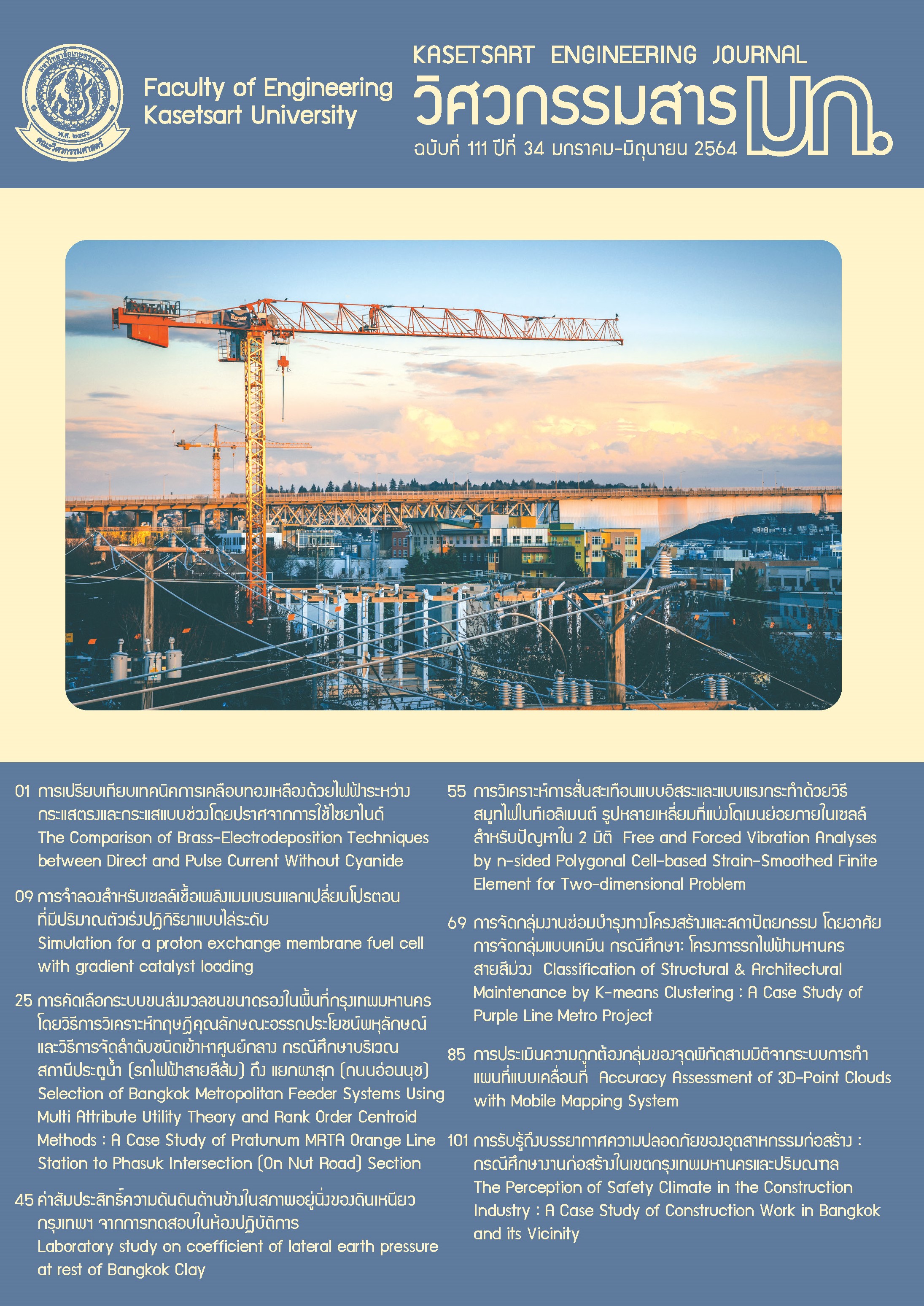ค่าสัมประสิทธิ์ความดันดินด้านข้างในสภาพอยู่นิ่งของดินเหนียวกรุงเทพฯ จากการทดสอบในห้องปฏิบัติการ
คำสำคัญ:
สัมประสิทธิ์ความดันดินด้านข้างในสภาพอยู่นิ่ง, การอัดตัวคายน้ำ, ดินเหนียวกรุงเทพฯ, การทดสอบแบบสามแกนบทคัดย่อ
งานวิจัยนี้ศึกษาค่าสัมประสิทธิ์ความดันดินด้านข้างในสภาพอยู่นิ่งของดินเหนียวกรุงเทพฯ จากการทดสอบการอัดตัวคายน้ำแบบ 1 มิติในห้องปฏิบัติการ การทดสอบการอัดตัวคายน้ำกระทำโดยใช้เครื่องมือทดสอบแบบสามแกนโดยการให้อัตราความเครียดคงที่ในแนวดิ่งและปรับค่าความเค้นในแนวนอนเพื่อให้ได้สภาพที่ความเครียดเชิงปริมาตรเท่ากับความเครียดในแนวดิ่ง เครื่องทดสอบแบบสามแกนได้รับการพัฒนาเพื่อให้สามารถวัดความเครียดในแนวดิ่งและความเครียดเชิงปริมาตรพร้อมทั้งควบคุมความเค้นในแนวนอนได้โดยอัตโนมัติ ผลการทดสอบคุณสมบัติการอัดตัวคายน้ำได้ทำการเปรียบเทียบกับผลการทดสอบ odometer ผลการทดสอบคุณสมบัติ Ko ได้ทำการวิเคราะห์เทียบกับความสัมพันธ์เชิงประสบการณ์และผลการทดสอบของผู้วิจัยอื่น และได้ทำการศึกษาข้อบกพร่องของผลการทดสอบ
เอกสารอ้างอิง
Franzius J N, Potts D M, and Burland J B (2005). The influence of soil anisotropy and Ko on ground surface movements resulting from tunnel excavation. Geotechnique, 55(3): 189-199.
Lambe T W, and Whitman R V (1969). Soil Mechanics. John Wiley & Sons.
Poulos H G, and Davis E H (1972). Laboratory determination of in-situ horizontal stress in soil masses. Geotechnique, 22: 177-182.
Folkes D J, and Crooks J H A (1985). Effective stress paths and yielding in soft clays below embankments. Canadian Geotechnical Journal, 22(3): 357-374.
Graham J, and Lau S L K (1988). Stress release, undrained storage, and reconsolidation in simulated underwater clay. Canadian Geotechnical Journal, 24: 275-288.
Jamiolkowski M, Leroueil S, and Lo Presti D C F (1991). Design parameters, from theory to practice. Geo-coast 91, 2: 877-917.
Jaky J (1948). Pressure in silo. Proc. 2nd Int. Conf. on Soil Mechanics and Foundation Engineering, Rotterdam, 1: 103.
Brooker E W, and Ireland H O (1965). Earth pressure at rest related to stress history. Canadian Geotechnical Journal, 2(1): 1-15.
Alpan I (1967). The empirical evaluation of the coefficient Ko and Kor. Soils and Foundations, 7(1): 31-40.
Bolton M D (1991). Geotechnical stress analysis for bridge and abutment design. Contractor Report 270, Crowthorne, Transport and Road Research Laboratory.
Simpson B (1992). Retaining structures: displacement and design. Geotechnique, 42(4): 541-576.
Schmidt B (1966). Discussion paper – Earth pressure at rest related to stress history. Canadian Geotechnical Journal, 3(4): 239-242.
Mayne P W, and Kulhawy F H (1982). Ko – OCR Relationships in Soils. Journal of the Geotechnical Engineering Division, ASCE, 108(GT6): 851-872.
Krogsbol A, Hededal O, and Foged N (2012). Determination properties of highly plastic fissured Plalaeogene clay – Lack of stress memory?. Proc. NGM 2012, Nordisk Geoteknikermode 1/2, pp. 133-140.
Lefebvre G, Bozozuk M, Philibert A, and Hornych P (1991). Evaluating Ko in Champlain clays with hydraulic fracture tests. Canadian Geotechnical Journal, 28(3): 365-377.
Hamouche K K, Leroueil S, Roy M, and Lutenegger A J (1995). In situ evaluation of Ko in eastern Canada clays. Canadian Geotechnical Journal, 32: 677-688.
Wroth C P (1973). General theories of earth pressure and deformation. Proc. 5th European Conference on Soil Mechanics and Foundation Engineering, 2: 33-52.
Bergado D T, Long P V, and Muthy B R S (2002). A case study of geotextile-reinforced embankment on soft ground. Geotextiles and Geomembranes, 20: 343-365.
Ladd C C (1991). Stability evaluation during staged construction. Journal of Geotechnical Engineering, ASCE, 117(4): 537-615.
Som N N (1970). Lateral stresses during one-dimensional consolidation of an over-consolidated clay. Proc. 2nd Southeast Asian Conf. on Soil Engineering, pp. 259-307.
Tavenas F A, Blanchette G, Leroueil S, Roy M, and La Rochelle F (1975). Difficulties in the in-situ determination of Ko in soft sensitive clays. Proc. ASCE Special Conf. on In-situ Measurement of Soil Properties, 1: 450-476.
Becker D E, Crooks J H A, Been K, and Jefferies M G (1987). Work as a criterion for determining in situ and yield stresses in clays. Canadian Geotechnical Journal, 24(4): 549-564.
Bishop A W (1958). Test requirements for measuring the coefficient of earth pressure at rest. Proc. Brussels Conf. on Earth Pressure Problems, 1: 2-14.
Burland J B, and Maswoswe J (1982). Discussion on In situ measurements of horizontal stress in overconsolidated clay using push-in spade-shaped pressure cells. Geotechnique, 32(2): 285-286.
Chang M F (1973). A rational method for determining the in-situ coefficient of earth pressure at rest. M.Eng thesis, AIT.
Wang W T (1975). Ko determination by hydraulic fracturing. M.Eng. thesis, AIT.
Shibuya S, Tamrakar S B, and Theramast N (2001). Geotechnical site characterization on engineering properties of Bangkok Clay. Geotechnical Engineering, SEAGS, 32(3): 139-151.
Prust R E, Davies J, and Hu S (2005). Pressuremeter Investigation for Mass Rapid Transit in Bangkok, Thailand. Transportation Research Record: Journal of the Transportation Research Board, 1928: 207-217.
Lai K C (1993). Comparison of Recompression and SHANSEP strength-deformation properties of undisturbed Bangkok clay. M.Eng. thesis, AIT.
ดาวน์โหลด
เผยแพร่แล้ว
ฉบับ
ประเภทบทความ
สัญญาอนุญาต

อนุญาตภายใต้เงื่อนไข Creative Commons Attribution-NonCommercial-NoDerivatives 4.0 International License.


